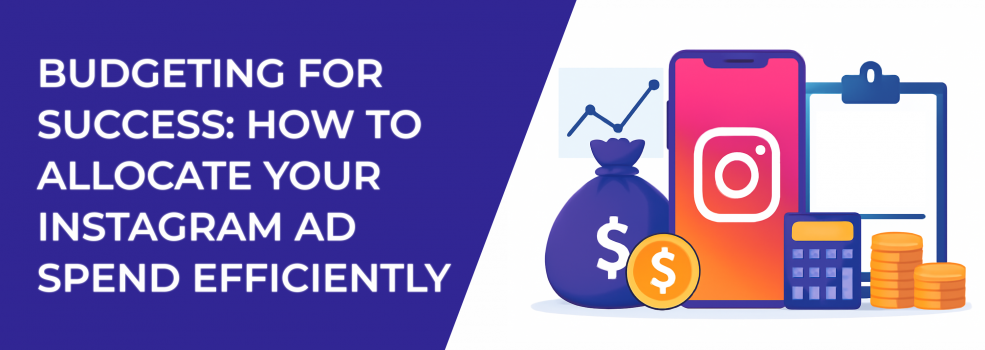When it comes to Instagram advertising, the phrase “you get what you pay for” isn’t entirely accurate. In fact, it’s more about how you pay and where you spend your budget. Whether you’re a small business owner or a marketer looking to refine your strategy, understanding how to allocate your Instagram ad spend is essential for seeing real returns on investment.
But let’s be honest — it’s not as straightforward as it seems. With a crowded marketplace, a multitude of targeting options, and creative challenges, how do you ensure that every penny is spent wisely?
Let’s break down how you can allocate your Instagram ad spend effectively and optimize your budget to achieve your goals.
Understand Your Objectives: Define the Bigger Picture
Before diving into budgeting, ask yourself: What do you hope to achieve with your Instagram ads?
This simple question will guide every decision you make. Are you looking to drive immediate sales, boost brand awareness, or increase engagement? The answer will shape everything — from your budget distribution to the kind of ads you create.
For example, if your goal is to increase sales or conversions, focusing your budget on performance-driven ads with a clear call-to-action (CTA) might be your priority. On the other hand, if you're trying to build brand awareness, you might want to allocate more budget toward reaching a broader audience.
Here’s a scenario: let’s say you run a local bakery and want to increase foot traffic. If you’re aiming for brand awareness, a broad reach might seem ideal. But if your goal is to drive in-store purchases, your budget should be focused on more localized targeting.
You can learn more about building brand awareness and setting clear marketing goals by checking out our How to Use Instagram Ads for Small Business Growth in 2025 article.
Break Down Your Audience: Quality Over Quantity
Instagram offers a plethora of targeting options — location, interests, demographics, behaviors, and more. But while these tools are powerful, not all of them are worth your time and money.
Many advertisers fall into the trap of casting a wide net, hoping to reach as many people as possible. The problem with this? Not everyone you reach will engage with or purchase from your business, leading to inefficient ad spend.
Instead of going broad, focus on quality. Here’s how:
-
Target your existing followers: if someone is already following you, they’re more likely to convert. Allocate part of your budget to retarget these users with specific offers or promotions.
-
Create lookalike audiences: use Instagram’s lookalike audience feature to target people who share similar traits with your current customers.
-
Refine based on interests and behaviors: target users based on their interests or behaviors related to your product. For instance, if you sell outdoor equipment, target those who have recently engaged with outdoor sports-related content.
By narrowing your audience, you ensure your budget is being spent on people who are more likely to engage, ultimately increasing your return on investment.
Additionally, comparing Instagram Ads to Facebook Ads can help you refine your audience targeting. Check out Instagram Ads vs Facebook Ads: Which Is Better for Your Business? to explore which platform might work best for your specific goals.
Experiment with Ad Formats: Test and Optimize
Instagram offers various ad formats — photo ads, carousel ads, video ads, and more. The key is to experiment with different formats to see which one resonates most with your audience.
Performance for different Instagram ad formats can vary, but you won’t know which works best for your campaign until you test them.
Running A/B tests is one of the best ways to ensure you’re allocating your budget efficiently. Test variables like:
-
Ad format: try carousel ads versus single image ads.
-
Ad copy: test different headlines or descriptions to see what catches your audience’s attention.
-
CTA: does “Shop Now” perform better than “Learn More” for your audience?
Start by allocating a small portion of your budget to test these variables, then scale up based on what performs best.
For example, imagine you’re promoting a new clothing line. If the image-based ad isn’t converting well, try switching to a video ad that shows the product in action. Allocating just a fraction of your budget for this experiment can lead to better insights and more effective spending.
If you’re curious about using video content to engage your audience, explore the potential of Instagram Reels to further enhance your marketing strategy.
Optimize for Timing: When is Your Audience Active?
It’s not just about how much you spend; it’s also about when you spend it. Understanding the best times to run your ads can have a major impact on your results.
Here’s what you should do:
-
Analyze Instagram Insights: check the activity patterns of your followers. When are they most active? You can use this data to schedule your ads during peak engagement hours.
-
Leverage dayparting: Instagram allows you to schedule your ads to run at specific times. If your audience is more active during the evenings, allocate more of your budget to those hours.
-
Monitor performance over time: as you collect more data, adjust your ad schedule. If you notice higher conversion rates at certain times of the day, redirect your budget to target those hours more effectively.
By running ads when your audience is most likely to engage, you can maximize the impact of your budget and increase conversions without spending extra.
If you’re focused on building more engagement, be sure to check out How to Use Instagram Stories for Audience Engagement and Conversions for tips on how to make your Instagram ads even more interactive.
Keep an Eye on the Metrics: Adjust on the Go
The beauty of Instagram advertising is that you can track your campaign’s performance in real time. But just because your ad is getting a lot of clicks doesn’t mean your budget is being used effectively.
Here’s how you can monitor and optimize:
-
Track conversion rates: don’t just look at clicks; focus on how many clicks lead to actual sales or other valuable actions.
-
Monitor cost-per-click (CPC): if your CPC is high, it could mean your targeting isn’t refined enough, or your ad copy isn’t compelling. Reallocate your budget to high-performing ads or test new creatives.
-
Look at return on ad spend (ROAS): this is your ultimate metric for success. If the ROAS is low, consider adjusting your targeting, creative, or bidding strategy.
A great tip is to set daily budgets that allow room for adjustments. If an ad is performing well, you can increase its budget. If it’s underperforming, consider pausing it and reallocating funds.
If you're interested in scaling your ad efforts while maintaining ROI, be sure to check out our post on Scaling Instagram Ads While Maintaining ROI: What You Need to Know.
Set a Realistic Budget and Stick to It
While it’s tempting to overspend in the hope of reaching more people, it’s important to be realistic about how much you can afford to spend.
Here’s how to set a realistic budget for different types of businesses:
1. E-commerce Store (Conversion-Focused)
Let’s say you run an online clothing store and your goal is to increase purchases during a seasonal sale. Since you’re focused on driving conversions, it’s important to allocate a larger portion of your budget to performance-driven campaigns such as product-specific ads, retargeting, and dynamic product ads.
Based on the budget allocation table, a good starting point is to assign 60% of your budget to conversion-focused ads, 30% to brand awareness campaigns, and 10% to remarketing or other types of ads.
For example, if your total monthly budget is $1,000, you’d allocate $600 for conversion-focused ads, $300 for brand awareness, and $100 for remarketing efforts. This ensures that your campaigns are geared towards generating direct sales, while still making room for visibility and engagement with potential customers.
2. Local Business (Brand Awareness and Foot Traffic)
Imagine you own a coffee shop in a bustling city and want to attract more foot traffic during a new product launch. For local businesses, geo-targeting is crucial to reach potential customers within a specific radius of your shop.
Based on the table’s suggested allocation, consider distributing your budget as follows: 40% for promoting the product launch, 30% for seasonal offers, and 30% for general brand awareness. This ensures you're building excitement for the launch while also keeping the momentum going with seasonal promotions and broader visibility.
For example, with a $500 budget, you would allocate $200 to the new product launch, $150 for seasonal offers, and $150 for brand awareness initiatives. This balanced approach helps you generate foot traffic without neglecting other important marketing goals.
3. Service-Based Business (Lead Generation)
Let’s say you run a digital marketing agency and your goal is to generate more leads. For service-based businesses, focusing on lead generation through valuable offers, such as free consultations or downloadable resources, is key to driving conversions.
In this case, allocating around 50% of your budget to lead generation campaigns with clear calls-to-action (e.g., “Book Now” or “Get a Free Consultation”) and 30% for remarketing ads is a good strategy, leaving 20% for brand awareness.
For instance, with a $1,500 budget, you would allocate $750 to lead generation ads, $450 for remarketing to previous website visitors, and $300 for brand awareness. This allocation ensures that your ad spend is focused on both attracting new leads and nurturing existing interest from people who’ve already engaged with your brand.
4. Event or Product Launch (Urgency & Excitement)
If you’re promoting an event or a new product launch, creating a sense of urgency and excitement is crucial. Your budget should be allocated in a way that builds anticipation early on and then shifts to drive last-minute conversions as the event or launch date approaches.
According to the budget allocation table, a larger portion of the budget should be spent early to build hype, with 70% allocated for pre-launch buzz and 20% for remarketing or final push ads as the date nears.
For example, with a $2,000 budget, you would allocate $1,400 in the early stages to generate excitement and build momentum, and $400 for final push ads closer to the event or product release. This approach allows you to drive awareness early and maintain urgency as the event date approaches, ensuring strong attendance or sales.
Conclusion: Budgeting Is an Ongoing Process
Mastering Instagram ads is not a one-time job. It’s a continuous cycle of planning, testing, analyzing, and adjusting. By understanding your objectives, narrowing your audience, experimenting with ad formats, and constantly optimizing your budget allocation, you can ensure your Instagram ads bring in tangible results.
Instagram gives you the tools you need to succeed. But remember, the real power lies in how you use those tools to make every dollar count. So, next time you sit down to plan your ad budget, ask yourself: how can you get the most out of every dolar spent?
Effective budgeting isn’t just about throwing money at ads. It’s about strategic, thoughtful investment that leads to measurable success.

